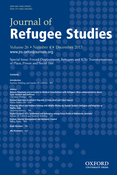-
Views
-
Cite
Cite
Btihaj Ajana, Asylum, Identity Management and Biometric Control, Journal of Refugee Studies, Volume 26, Issue 4, December 2013, Pages 576–595, https://doi.org/10.1093/jrs/fet030
Close - Share Icon Share
Abstract
The article addresses a particular aspect of the relationship between asylum issues and information and communication technologies (ICTs), namely the deployment and ‘function creep’ of biometrics within the field of asylum management. Current debates on this issue have been largely restricted to a technologically determinist approach that reduces the focus to problems of data misuse and privacy, precluding other pertinent ethical and political concerns. In response, the article engages with Giorgio Agamben’s elaborations on the concepts of biopolitics and exception as an alternative way of analysing the use of biometric technology in the governance of forced migrants. It begins with a critical overview of Agamben’s conceptualization of biopolitics and the state of exception. It then considers the Eurodac database and the UK’s asylum Application Registration Cards as examples to demonstrate how current policies of immigration control and border management are implicated in the logic of exception. It argues that illiberal practices, such as biometric profiling and fingerprinting of asylum seekers and their incarceration in detention centres, are being enforced upon certain groups in ways that render their exclusion from the official juridico-political structure as an ‘inclusive exclusion’. Importantly, the function creep of biometrics is not to be understood as the turning of exception into the rule in a somewhat homogenous way, but more as a polysemic process, which involves different forms of discipline and control that are irreducible to one singular paradigm.


